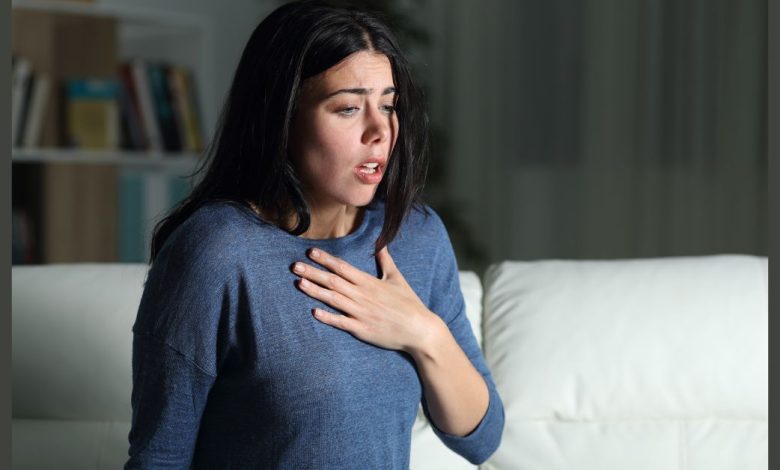Labored breathing, breathlessness: what is this, causes, symptoms, diagnostics, treatment, prevention

Breathing difficulty; Shortness of breath; Breathlessness; Difficulty breathing; Dyspnea
Labored breathing, also called shortness of breath, is a common condition, from which many people suffer. Difficulty breathing is a feeling of discomfort or restlessness when breathing, which can range from mild to severe and can make it difficult to do daily activities or even simple tasks, such as climbing stairs.
Shortness of breath is a symptom, not the state itself. This could be a sign of an underlying health problem., so it's important to see a doctor, if difficulty breathing occurs regularly or is accompanied by other symptoms.
What is difficulty breathing?
Difficulty breathing is a feeling of discomfort or restlessness when breathing. It's a symptom, not the state itself, and can range from mild to severe. People may experience shortness of breath, wheezing, narrowing in Gruda, chest pain and difficulty getting enough air into the lungs. If difficulty breathing occurs regularly or is accompanied by other symptoms, it is important to seek medical attention, so what could be the root cause.
Causes of difficulty breathing
Difficulty breathing can be caused by a number of conditions, including asthma, COPD, pneumonia and congestive heart failure. Other causes include airway obstruction, anemia, allergies, COPD, asthma, lung cancer, pulmonary embolism and chronic bronchitis. In some cases, difficulty breathing can be caused by psychological conditions., such as anxiety or panic disorder.
Symptoms of difficulty breathing
Symptoms of difficulty breathing may vary depending on the underlying cause, but in general they include:
- Breathlessness
- wheezing
- Refine in Gruda
- Chest pain
- Difficulty getting enough air into the lungs
- Difficulty speaking or speaking in short sentences
- Feeling light or dizzy
- Rapid breathing
- Feeling tired or lacking energy
- coughing
- Feeling short of breath after little physical activity
- Sleeping problems
- Difficulty concentrating
When to contact a healthcare professional
If difficulty breathing occurs regularly or is accompanied by other symptoms, it is important to see a doctor. It is important to tell your doctor, if you have any of the following symptoms:
- Breathlessness, that comes on suddenly or gets worse
- Coughing up blood
- Chest pain
- It's hard to speak
- Feeling light or dizzy
- Rapid breathing
- Sleeping problems
Questions, that your doctor may ask
Your doctor, probably, ask you a series of questions, to determine the cause of difficulty breathing. Questions may include:
- When you started having trouble breathing?
- How long does it take?
- It occurs during activity or at rest?
- Do you have any other symptoms, such as chest pain or fatigue?
- Do you have a history of asthma, COPD or other respiratory diseases?
- Are you exposed to any environmental pollutants?
- Do you feel anxious or stressed?
- Have you recently had a cold or the flu?
Diagnosis of shortness of breath
To diagnose difficulty breathing, the doctor will perform a physical examination and ask you questions about your medical history. Your doctor may also order a series of tests, to determine the cause of difficulty breathing, eg, chest X-rays, spirometry or blood tests.
Treatment of shortness of breath
Treatment for difficulty breathing depends on the underlying cause. Treatment may include medication, lifestyle changes or oxygen therapy. In some cases, surgery may be required to relieve airway obstruction..
Medicines
Medications are often prescribed, to help open the airways and reduce inflammation in the lungs. Common medicines for breathing difficulties include bronchodilators, corticosteroids, anticholinergics and leukotriene modifiers.
Lifestyle Changes
Lifestyle changes may be needed to reduce symptoms and improve quality of life. This may include avoiding triggers., such as tobacco smoke, avoidance of low temperatures, wearing a face mask in public, smoking cessation and regular exercise.
Kislorodnaya therapy
Oxygen therapy may be needed in severe cases of difficulty breathing. Oxygen therapy involves inhaling supplemental oxygen, to improve oxygen delivery to the lungs.
home treatment for shortness of breath
In addition to medical treatment, there are some home treatments, which can help relieve symptoms of difficulty breathing. These include using a humidifier, trigger avoidance, regular exercise and over-the-counter medications.
Prevention of shortness of breath
In most cases, difficulty breathing is caused by an underlying medical condition or environmental factors.. To prevent shortness of breath, it is important to identify and avoid triggers, such as tobacco smoke, chemicals and low temperatures. Besides, it is important to exercise regularly and treat any comorbidities.
Conclusion
Difficulty breathing is a common condition, which can range from mild to severe and can make daily activities difficult.
It is important to see a doctor, if difficulty breathing occurs regularly or is accompanied by other symptoms.
Treatment for difficulty breathing depends on the underlying cause and may include medication, lifestyle changes, oxygen therapy and home treatments.
To prevent shortness of breath, it is important to identify triggers and avoid them, exercise regularly and seek treatment for any underlying conditions.
Used sources and literature
Braithwaite SA, Perina D. Dyspnea. In: Walls RM, Hockberger RS, Gausche-Hill M, eds. Rosen’s Emergency Medicine: Concepts and Clinical Practice. 9th ed. Philadelphia, PA: Elsevier; 2018:chap 22.
force m. Approach to the patient with respiratory disease. In: Goldman L, Schafer AI, eds. Goldman-Cecil Medicine. 26th ed. Philadelphia, PA: Elsevier; 2020:chap 77.
Schwartzstein RM, Adams L. Dyspnea. In: Broaddus VC, Serious JD, King TE, et al, eds. Murray and Nadel’s Textbook of Respiratory Medicine. 7th ed. Philadelphia, PA: Elsevier; 2022:chap 36.
